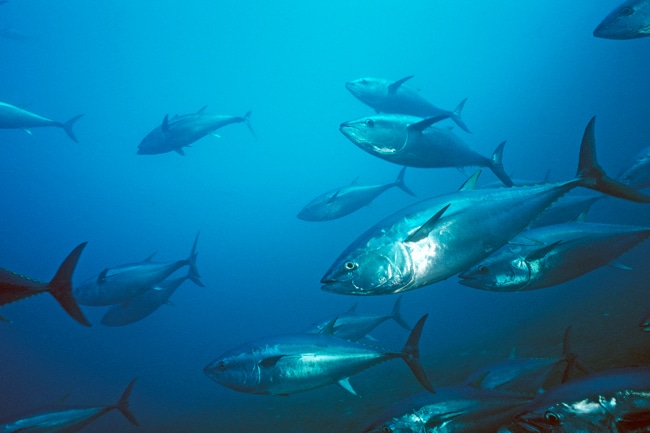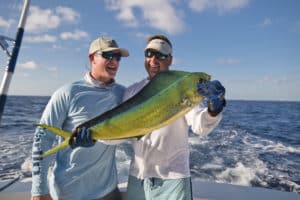
Pacific Bluefin Tuna
Next week, the Pacific Fishery Management Council (PFMC) will decide on new recreational limits for bluefin tuna for United States fishermen. While the PFMC will address other important measures during its six-day session in Costa Mesa, California, none is of greater interest to anglers than the bluefin plan, which scheduled for a vote on Nov. 17.
We’ll get to the proposed plan, where I stand and how you might influence the decision-making process in a minute. But first, here’s some background
This all started when the Center for Biological Diversity (CBD) petitioned the National Marine Fisheries Service last August, calling for a halt to all Pacific bluefin tuna fishing in the wake of studies by the International Scientific Committee for Tuna and Tuna-like Species in the Northern Pacific (ISC) indicating that the bluefin population now hovers at 4 percent of its original size. A moratorium will help give the bluefin stocks an opportunity to rebuild, the CBD points out.
“Any way you look at it, these bluefin tuna are in serious trouble,” said Catherine Kilduff at the CBD. “We know they’ve declined 96 percent since large-scale fishing began, and we know the only responsible way to preserve the long-term health of this beautiful fish — and any prospect for fishing for them in the future — is to prohibit catching them now until scientists have determined they have recovered.”
CONTRADICTORY EXPERIENCES
To the West Coast angling community, this flies in the face of the spectacular fishing for bluefin tuna off Southern California and Mexico’s northern Baja California over the past couple of years. In 2013, the recreational catch of Pacific bluefin tuna was 984 metric tons, eight times that of the 2010 catch of 122 metric tons. These numbers, by the way, include fish caught in Mexican waters by U.S. boats. This year isn’t over, but fishing was again good.
Interestingly, the Pacific bluefin tuna fishery is one of the few in which the U.S. recreational catch sometimes exceeds the commercial take. In 2013, for example, commercial landings reported 500 metric tons – nearly half of the sport-caught bluefin.
Of course, this doesn’t include commercial hauls in other countries. And that’s where the real problem lies. The Western and Central Pacific Fisheries Commission (WCPFC) and Inter-American Tropical Tuna Commission (IATTC) have failed to substantially curb overfishing, and so greedy commercial operations have decimated the Pacific bluefin population. As few as 40,000 adult Pacific bluefin tuna remain, according to estimates extrapolated from the ISC study.
Yet, if that’s the case, why are West Coast anglers catching so many Pacific bluefin tuna? No one knows for sure, but two sources I interviewed acknowledged that the past couple of years have been extraordinary in terms of the large number of bluefin tuna off the coasts of Southern California and northern Baja. Yet they also point out that this does not represent the population as a whole.
LOCAL ANOMOLY
“I believe what we have been seeing off the West Coast is a remnant population,” said one local, independent marine biologist, who asked to remain anonymous for fear of harassment and threats. “The highly migratory Pacific bluefin found the right water temperature and available food and remained off the coast for a long time.”
Biologists point to concentrations of dwindling populations of other migratory species, including blue and sperm whales collecting in great numbers in West Coast areas where environmental conditions proved favorable.
“A large local population might lead one to believe that a species is abundant, but based on the data, it is an illusion,” said the biologist. “Scientific evidence trumps anecdotal experiences every time.”
Jamie Gibbons, policy researcher for the Pew Charitable Trusts, adds: “We have seen concentrations of bluefin that are higher than normal [off Southern California]. But it is hard to generalize based on just a small piece of the puzzle. It’s like looking through a microscope.”
In addition, many of the fish coming over the rail on the West Coast have not yet reached sexual maturity, which is generally acknowledged to occur when a Pacific bluefin reaches 3 to 5 years of age and 70 to 90 pounds. While anglers were catching bluefin up to 120 pounds, most of the tuna were under 50 pounds.
JURISDICTIONAL ISSUES
The unfortunate fact of regulating the Pacific bluefin tuna fishery is that the PFMC has little jurisdiction over the commercial catch of this species. The U.S. has largely acquiesced regulation of this highly migratory fish to the multi-national IATTC. It’s akin to the United Nations – it can set policy, but has little enforcement ability. The upshot is that the PFMC can effectively regulate only recreational fishing for tuna.
The proposal before the PFMC – known as the preferred alternative plan – calls for a reduction in the recreational bag limit to 2 fish from the current bag limit of 10 fish. It should be noted that the take of bluefin tuna in Mexican waters is now prohibited all together by mandate of the Mexican government.
The preferred alternative plan before the PFMC is less than the three-fish daily bag limit that the Sportfishing Association of California wants, but more than the zero take that the CBD demands. Some might argue that two fish represent an 80 percent reduction from the current 10-fish limit. Yet the actual catch of bluefin averages one to two fish per day, and so for all practical purposes, this is really not a reduction at all.
Reduction or not, the plight of the Pacific bluefin is not of our making. Yet I am willing to sacrifice if it means setting an example for the rest of the world and giving this magnificent fish a chance to rebound. I have never shied away from stricter limits on gamefish – as long as I can still fish for them. Ultimately, I can accept the two-fish daily recreational limit on Pacific bluefin tuna.
FORGING AN ALLIANCE
While the CBD wants a complete suspension, not all such organizations have taken a hard line. The Pew Charitable Trusts supports the idea of maintaining a recreational fishery for Pacific bluefin. And so here anglers might find an ally, albeit one that has not always acted in concert with the recreational fishing community. But this time, our interests may align with Pew. To help solidify this, Pew is actively reaching out to anglers to garner support for the preferred alternative plan in two ways.
The first is a form letter to send to the PFMC in advance of the Nov. 17 session in support of a two-fish limit. In the interest of full disclosure, Pew’s official position favors a one-fish daily bag limit, but the group also recognizes that anglers will hesitate to sign a letter that limits the daily catch to one. So it drafted a letter making it easy to support the preferred alternative plan. Pew also favors a complete suspension of commerical fishing, but this is an issue the group will tackle with the IATTC.
In addition, Pew has invited all anglers to a special reception on Sunday, Nov. 16 at the Costa Mesa Hilton from 6 to 8 pm. This event will give you the rare opportunity to talk one-on-one with members of the PFMC – some of whom also served on the IATTC – in a more relaxed and perhaps more persuasive atmosphere than in the formalized public comment portion of the 3-hour session the following day, which I encourage you to also attend. If you plan to attend the Pew reception, RSVP here.
While you might not agree with all of Pew’s policies and actions, keep in mind that recreational anglers are facing enemies on two fronts – less-than-sympathetic environmental groups such as the CBD on one front and commercial fishing interests on the other. Forging an alliance with Pew might help us with both.






